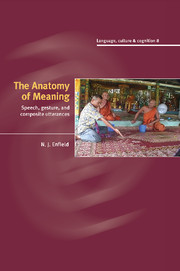5 - Modelling
Published online by Cambridge University Press: 21 July 2009
Summary
Is it even always an advantage to replace an indistinct picture by a sharp one? Isn't the indistinct one often exactly what we need?
Ludwig Wittgenstein, 1953This chapter considers composite utterances whose goal is to describe the forms and functions of complex artefacts – in this case, traditional fish traps made and used in Lao-speaking villages. In these utterances, hand movements are in the foreground, modelling and depicting, bearing a significant load in conveying meaning at the utterance level. The data presented in this chapter address a key issue in the semiotics of hand gestures, namely the question of whether non-linguistic components of composite utterances show linear segmentation and combinatoric dependencies. The data discussed below show that the hand movement components of a sequence of composite utterances can involve linear segmentation and combinatoric dependency. This is not to say that gestures are static, arbitrary signs (pace McNeill 2005: 75) – they are not. It is perhaps on terminological grounds that one might disagree with a claim that the data discussed in this chapter reveal a combinatorics to sequences of gesture, for example, in the sense that Hasan (1968: 18–24) insists that textual cohesion is ‘not structure’ (cf. Halliday and Hasan 1976). But my aim here is to draw attention to commonalities between semiotic relations within the move and semiotic relations across moves. There are relations of dependency among gestures in enchronically adjacent moves, where the interpretation of one sign is directly dependent on where it stands with reference to another sign.
- Type
- Chapter
- Information
- The Anatomy of MeaningSpeech, Gesture, and Composite Utterances, pp. 113 - 148Publisher: Cambridge University PressPrint publication year: 2009

